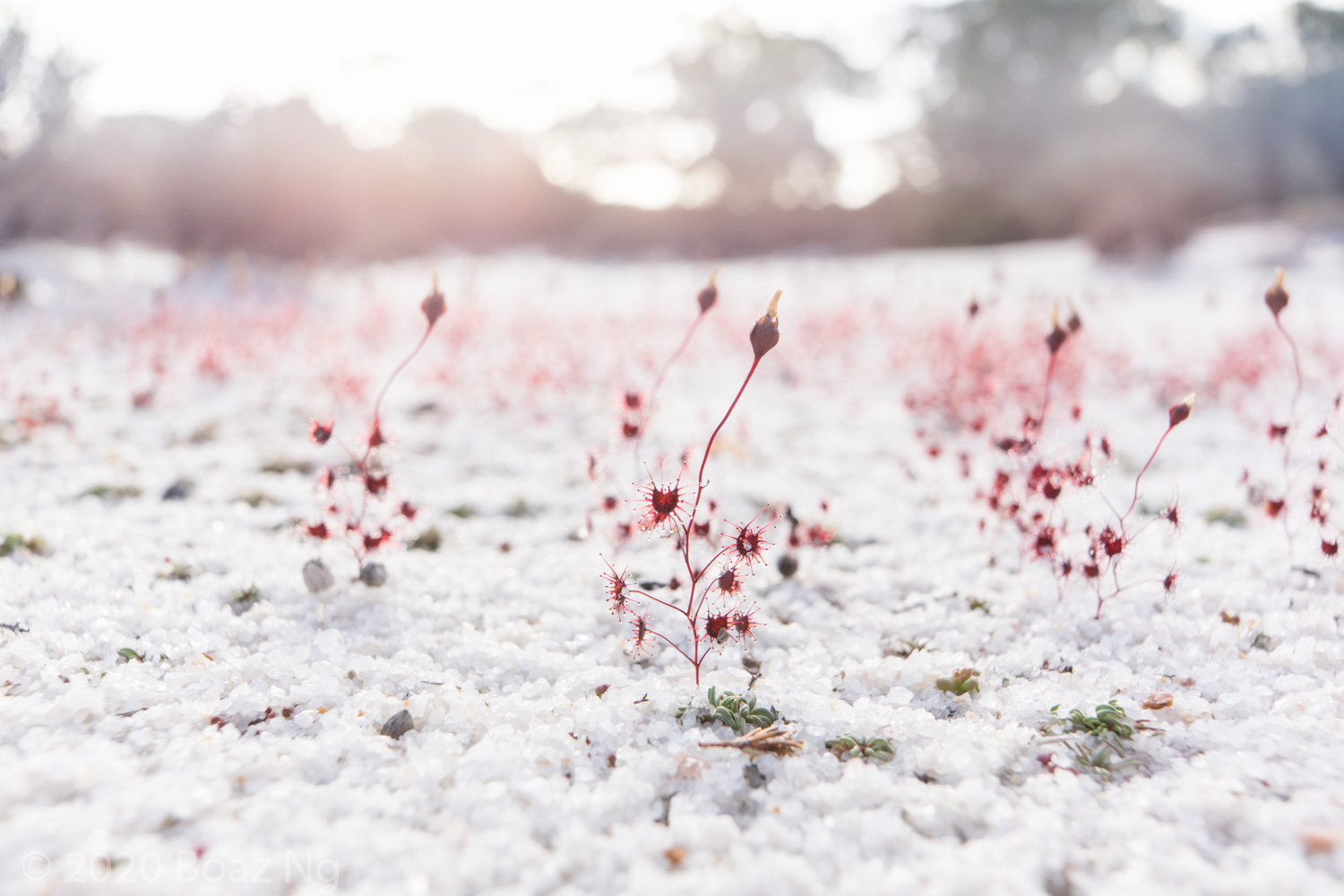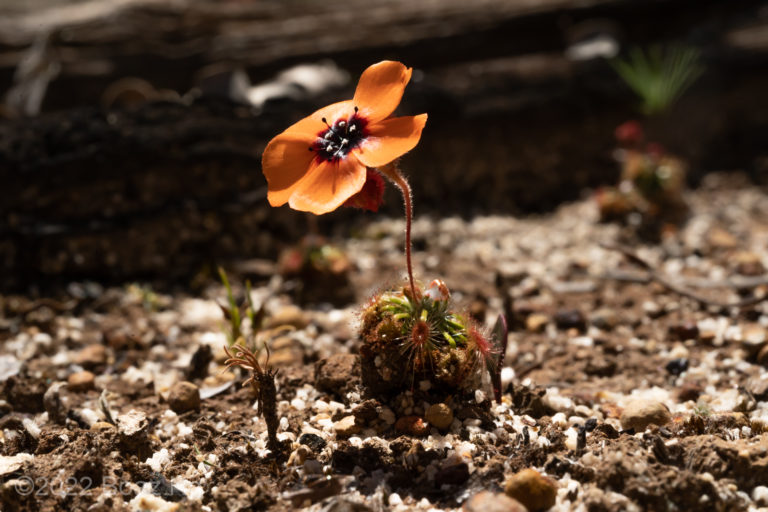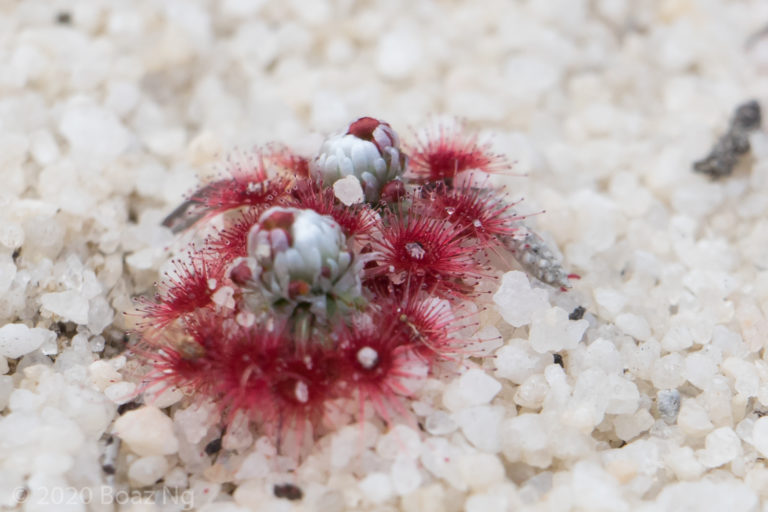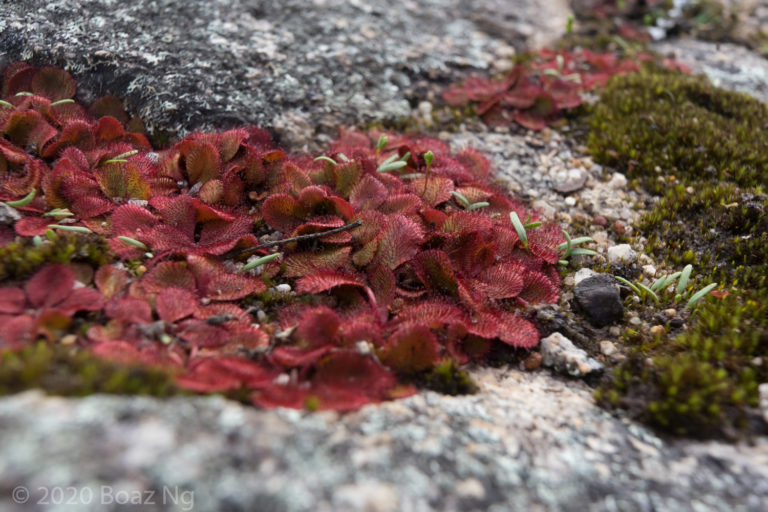At the end of winter in 2019 I embarked on an expedition to document the carnivorous plants of Western Australia. Over 17 days, I drove almost 3,500 km and photographed over 50 species in their habitat.
Previous: Part 5. South Coast Heath and Mallee
The Wheatbelt region is named for its extensive plains, which have overwhelmingly been cleared for agriculture. Pockets of indigenous biodiversity occur within the sparse nature reserves, which are mainly centred around the major geographical features of this harsh landscape. Here, ancient granite inselbergs the size of hills rise dramatically out of the surrounding fields and most permanent watercourses are saline from the accumulation of minerals over millennia. It is around these outcrops and salt lakes that I focused my attention for the next few days, allured by rumours of the rare sundews that congregate around them.
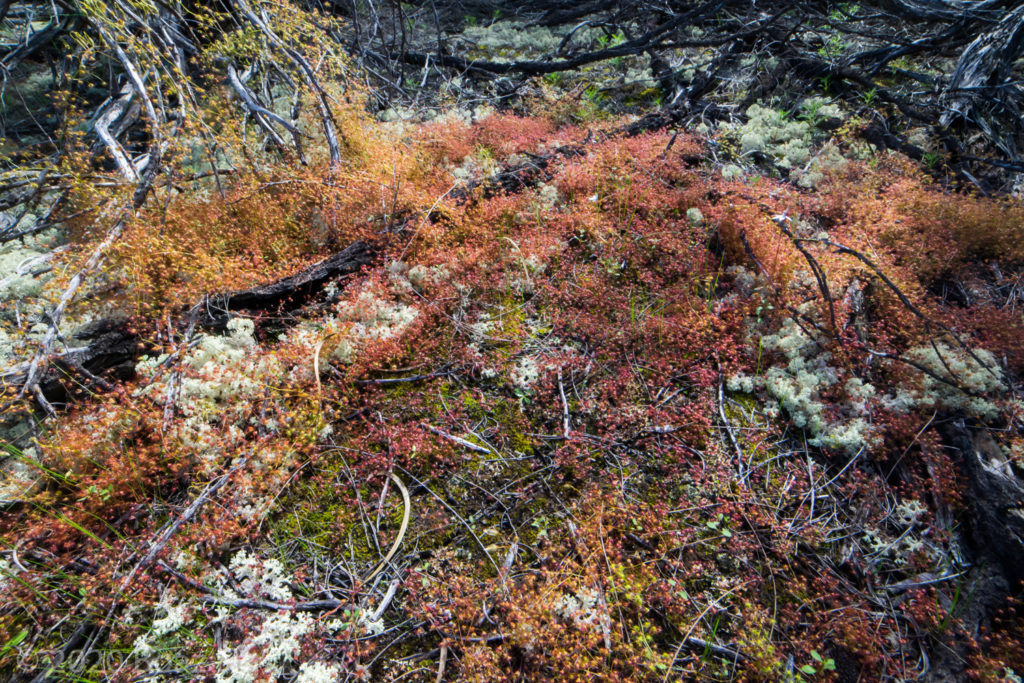
Drosera macrantha and subhirtella growing in the scrub around a granite outcrop 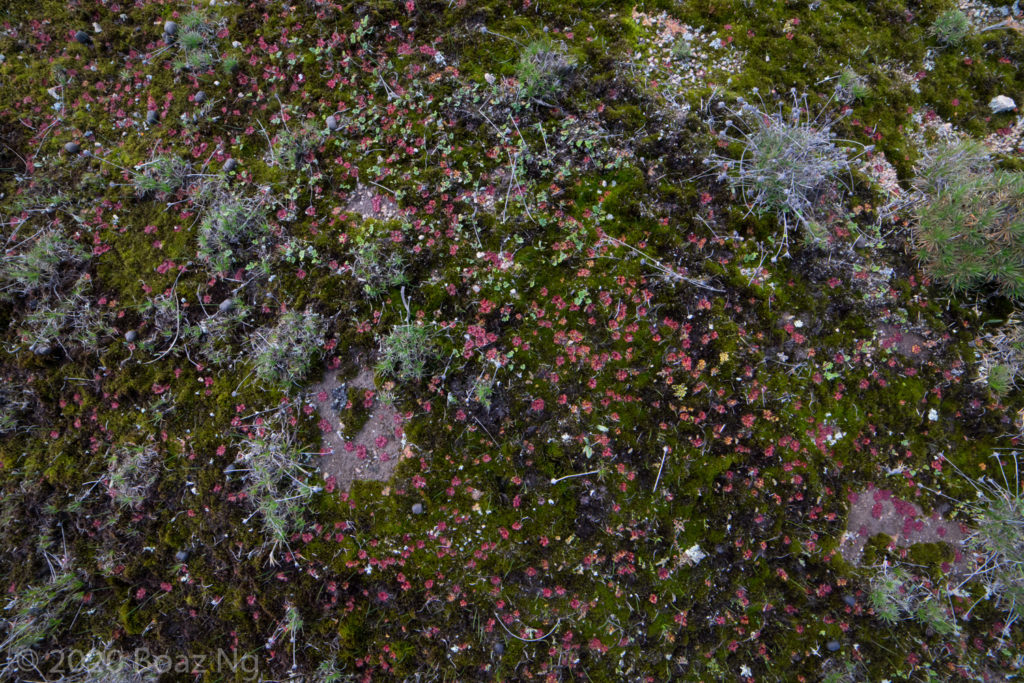
Hundreds of Drosera lowriei grew in the moss on top of the rock 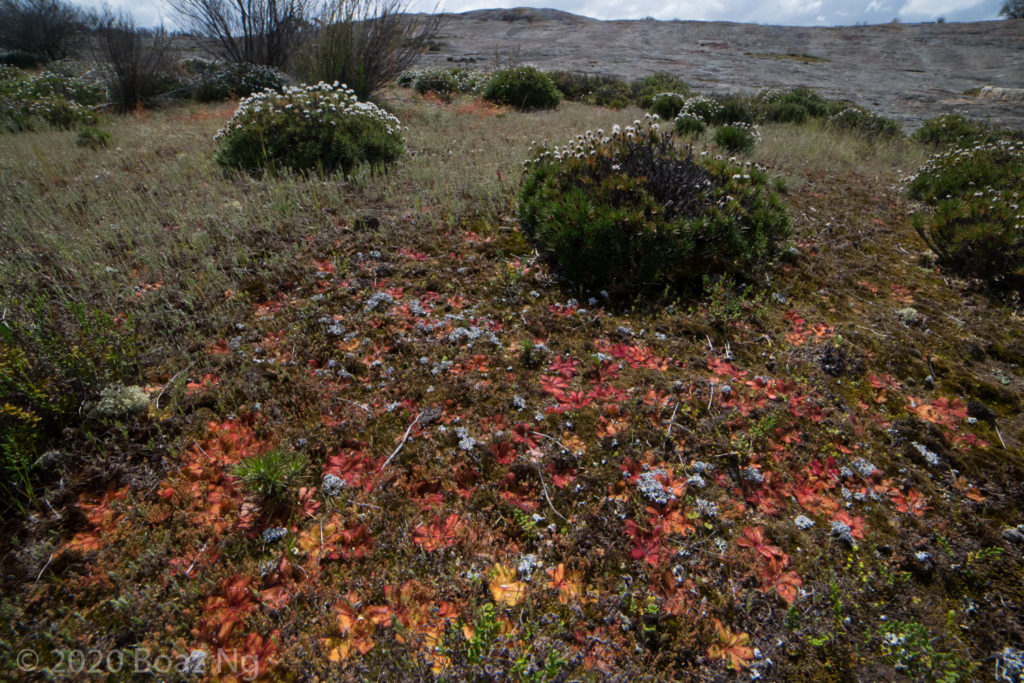
Drosera bulbosa covered the ground like colourful confetti 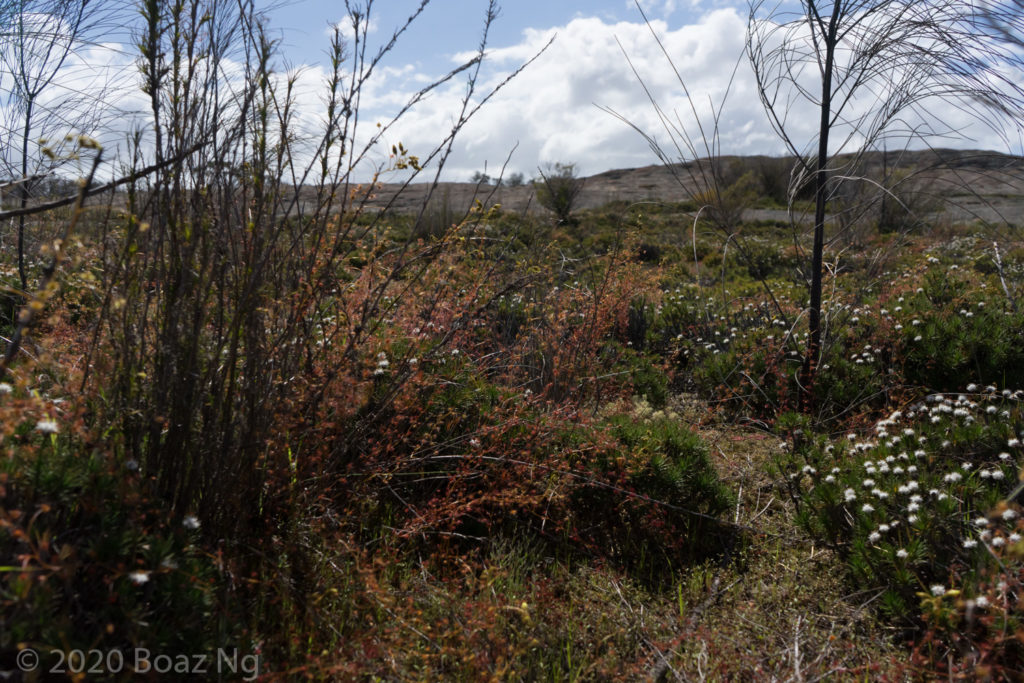
Drosera subhirtella in a depression on a granite outcrop.
As I approached the first granite outcrop, nothing could have prepared me for the sheer scale of everything I was about to experience. These giant red monoliths were simply huge, and I was surprised by how lush the areas around them were. Upon reaching the rock, I noticed that the scrub was covered in a strange orange growth. I quickly realised in awe that this was actually masses of D. subhirtella and D. macrantha that grew so thickly they blanketed the ground and surrounding bushes. Walking onto the rock surface, I immediately noticed that the thin layers of moss that covered wetter areas were studded with thousands of D. lowriei. Star shaped D. bulbosa, coloured in shades of yellow and red covered the peaty outwashes like confetti after a festival. I spent almost an hour wandering the rock, which must have occupied around a hectare in space, finding orchids and sundews wherever I looked.
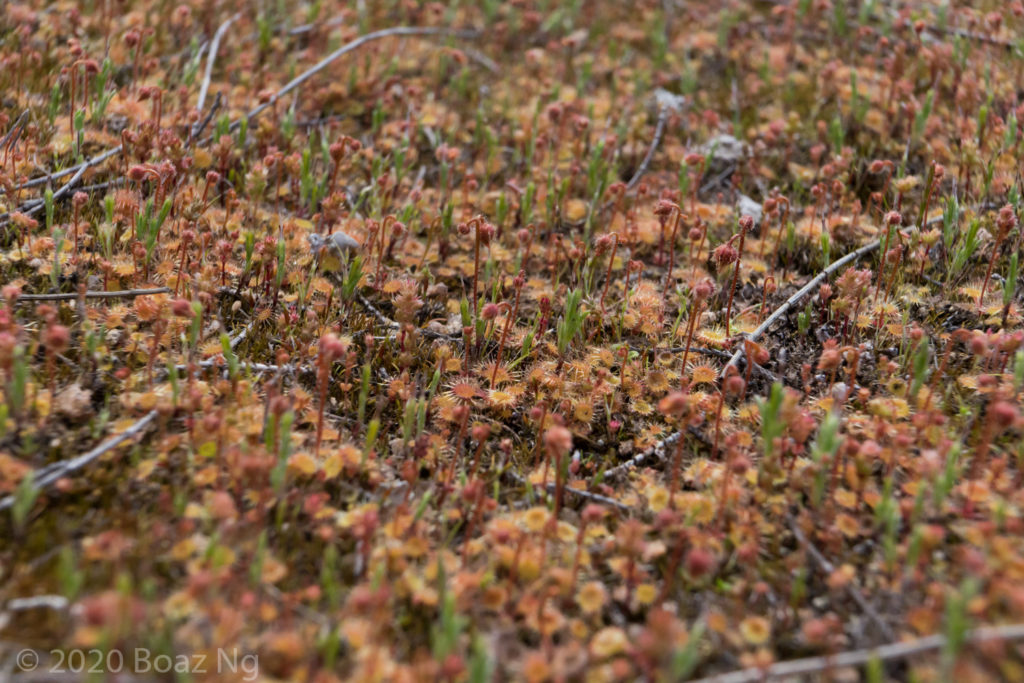
Drosera glanduligera 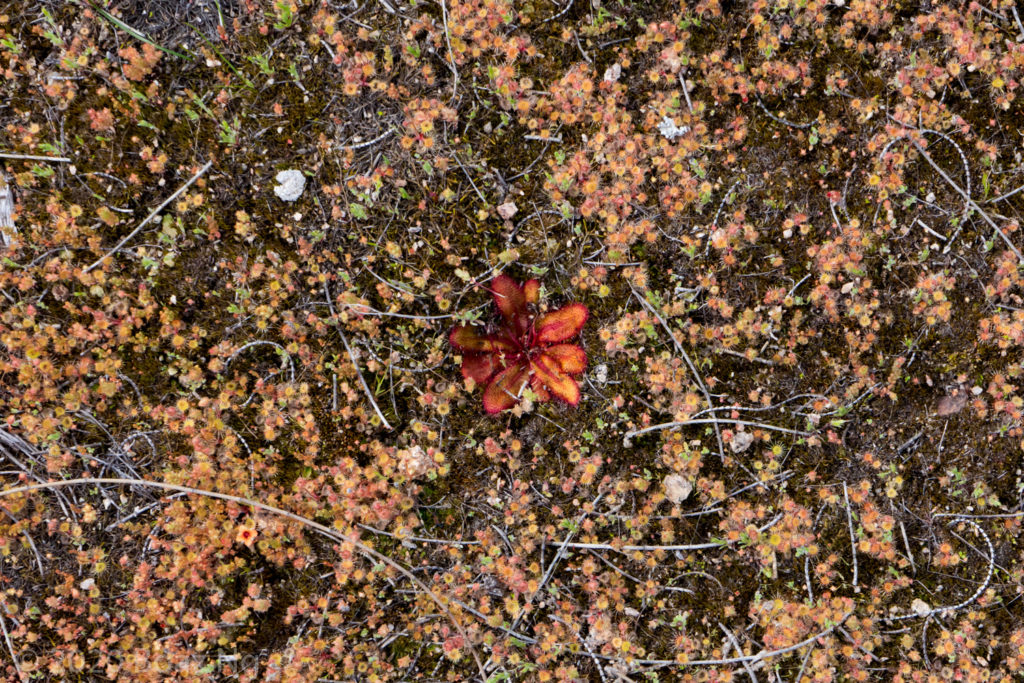
Drosera glanduligera
I had a few more sites marked out for exploration that day, and with enthusiasm I drove off to another outcrop. This one was covered in D. glanduligera, which grew so densely that the ground was endowed with a metallic glow. At the following rock, thousands of D. graniticola occupied its base. This species is notable for producing a massive floral inflorescence with more than 20 concurrent white blooms. The entire field was beautifully covered in white flowers, with a display that surely rivals the non-carnivorous wildflowers that the region is known for.
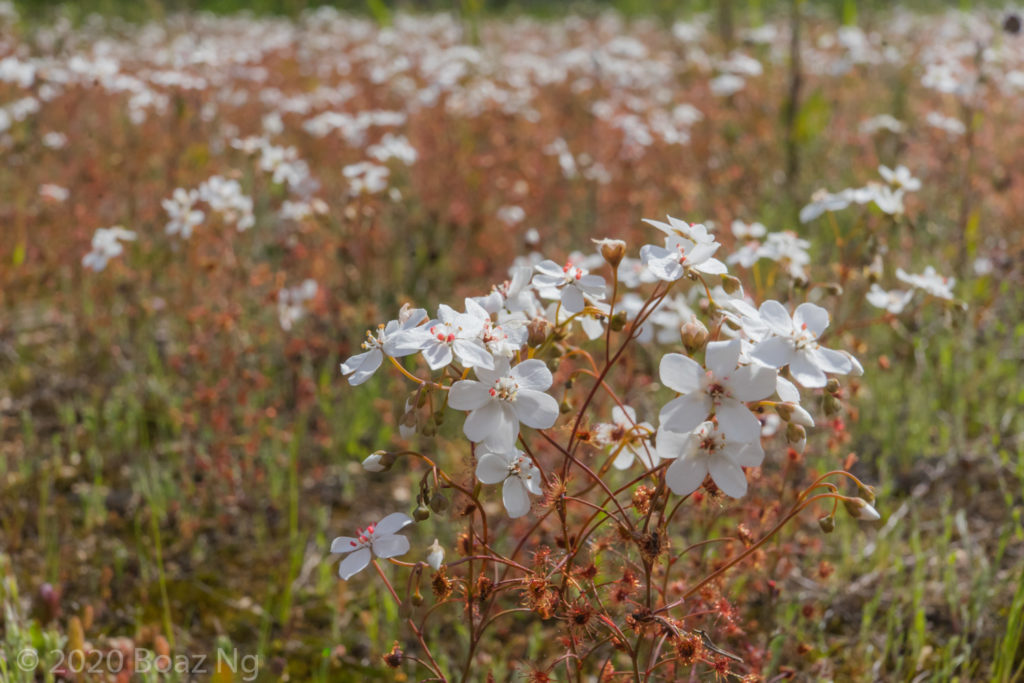
But the goal I had set for the day was to find two rare species of sundew with enigmatic niches that I wanted to better understand – Drosera salina and D. zigzagia which grow only around salt lakes in the Wheatbelt. It confused me as to how this could be, as high mineral contents are usually detrimental to carnivorous plants.
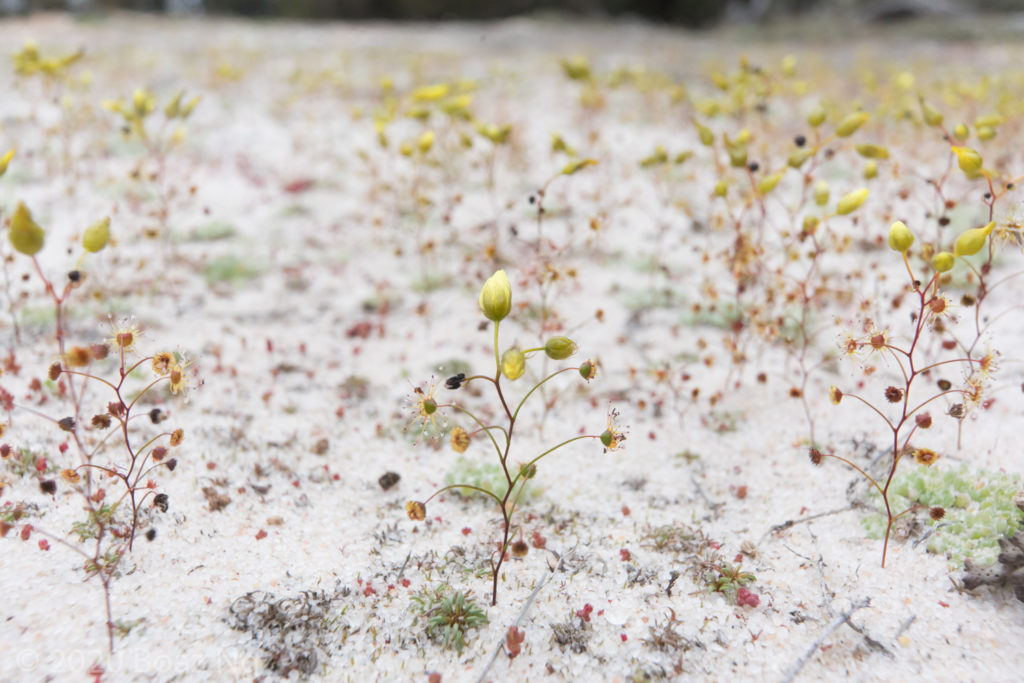
By now it was late afternoon and rain clouds were starting to develop, so I hurried off to visit a salt lake site that I had been tipped off about. I was surprised to find that this ‘lake’ was only the size of a large pond and was a lot smaller than some of the systems I had investigated earlier in the day. As I walked towards the water, I suddenly found that I was surrounded by a field of D. zigzagia! As its name suggests, the tiny species has zigzagging erect stems that reverse direction at every leaf node.
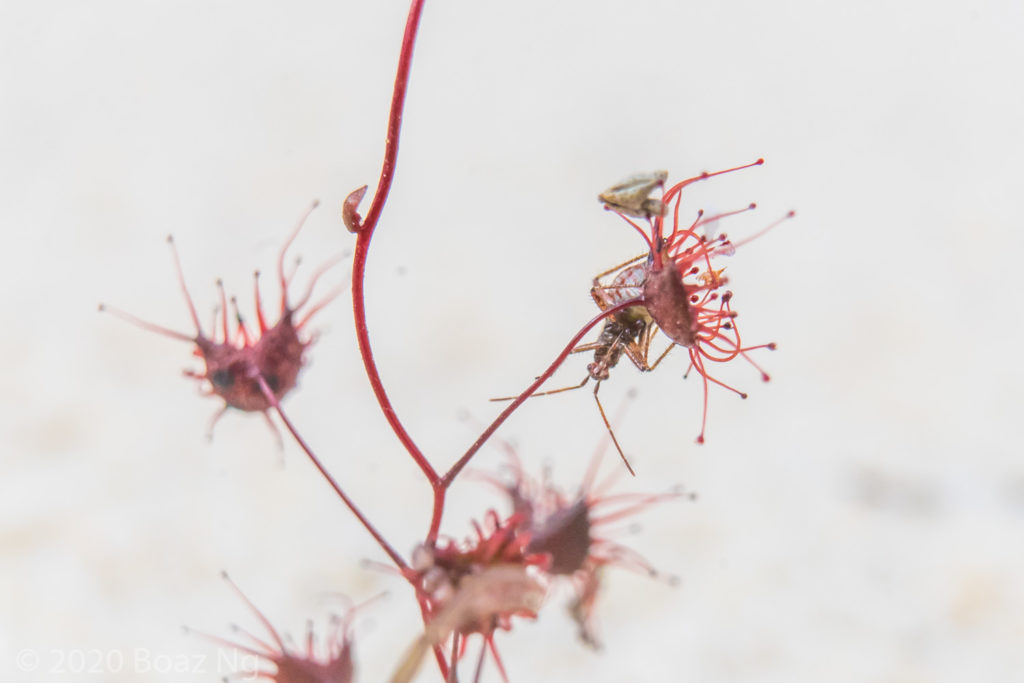
My attention then turned to finding D. salina and I walked to the other side of the lake, but was confused by its absence. I returned to the water line to inspect it more closely and found that I had literally walked right past the plants, not noticing them as they were so small! Compared to the golden leaves of D. zigzagia, D. salina is coloured dark red and has stems around half as tall. The species has a substantial basal rosette, but this is always buried under a layer of crystalline silica sand. Interestingly, while the two species grew within meters of each other, they never intermixed. D. salina grows on sloping surfaces close to the edge of the lake, whereas D. zigzagia prefers flat ground elevated from the shores.
Suddenly a downpour developed, and I was forced to cut my exploration short and run back to the car. I decided that it was about time I made my way to the motel in Hyden, which was still a good hour’s drive away. Of course, the spirit of exploration overcame me, and I stopped at one more granite outcrop that I had marked on my map.
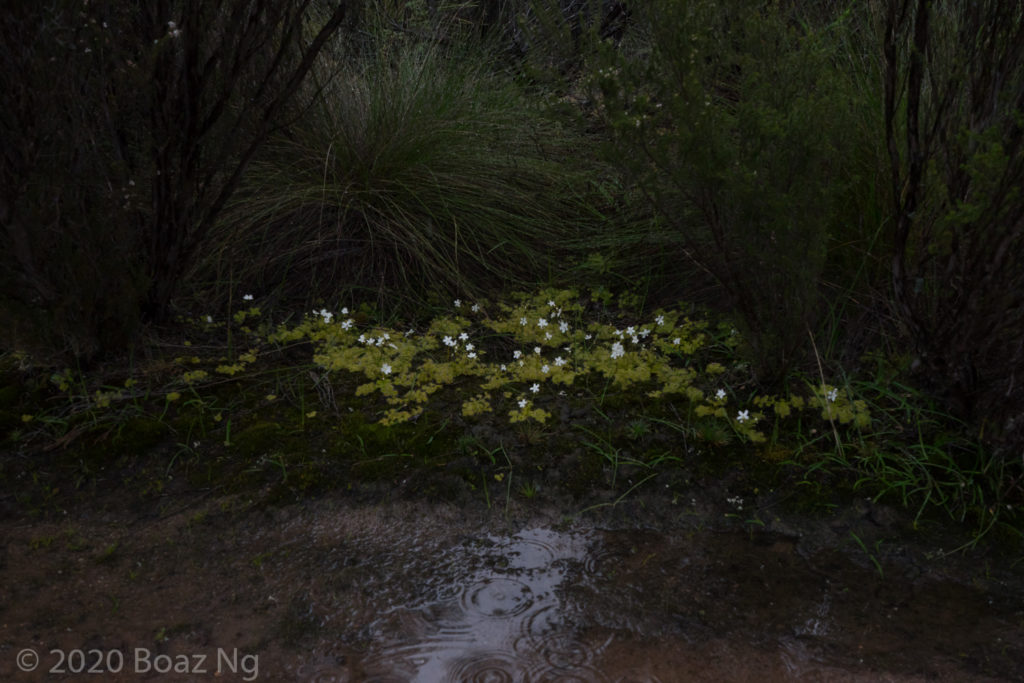
Drosera rupicola 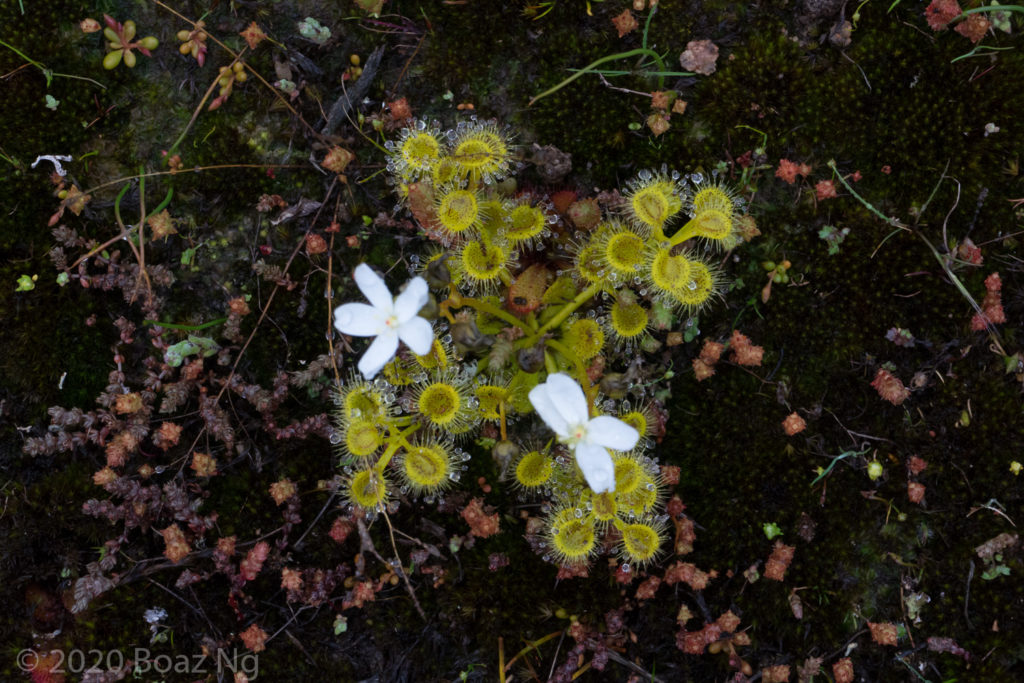
Drosera rupicola 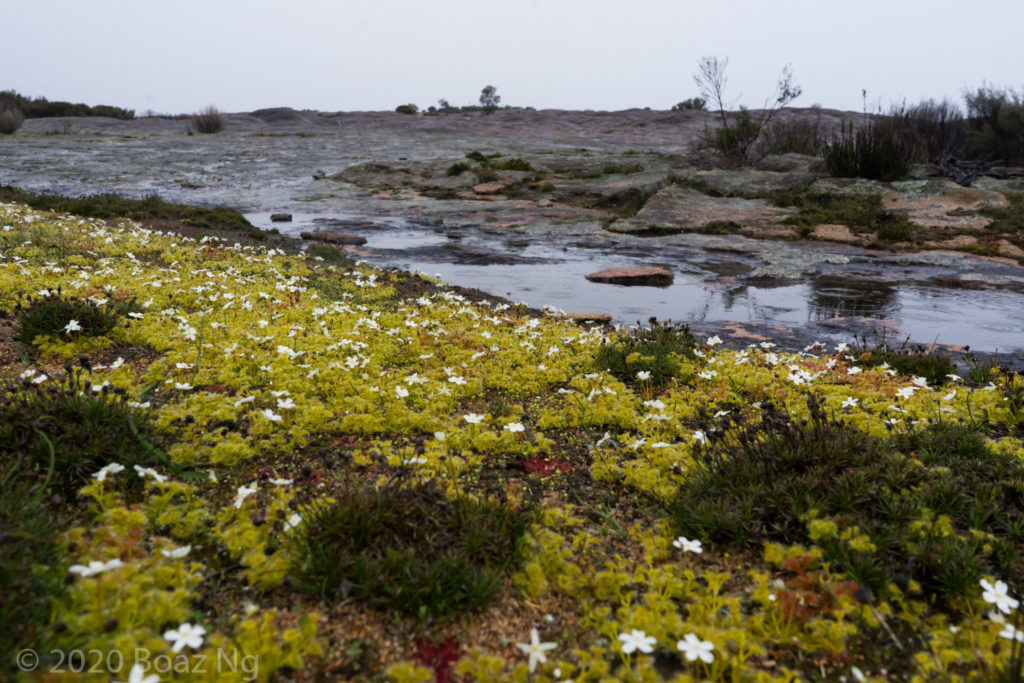
Drosera rupicola 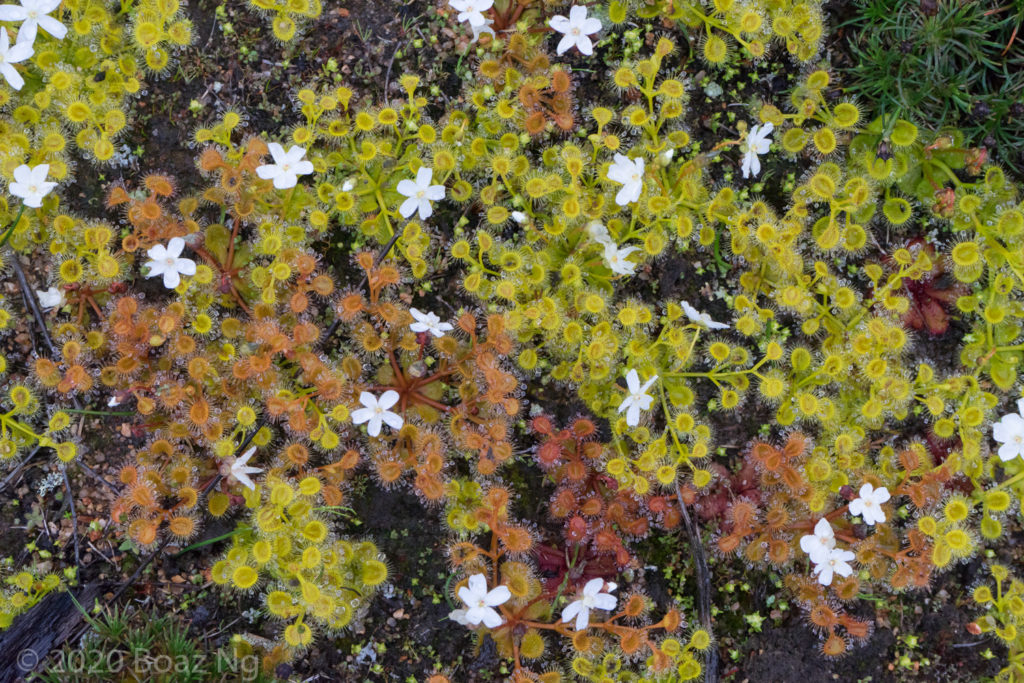
Drosera rupicola
I’m glad I did so as it was only after seeing this location in the rain that I truly appreciated the ecological role of the outcrops in the Wheatbelt. Small cascades of water had formed in the weathered channels on the rock surface and gathered in deep pools of water around its base. I came to the realisation that these giant impermeable surfaces are very effective at collecting and concentrating rainwater, forming seasonal accumulations of moisture that support the hundreds of endemic species of the area. Drosera rupicola, a large sprawling fan-leaved species, grew in full bloom at the edge of the water pools whilst D. lowriei and D. bulbosa were temporarily submerged under a stream of fresh water. Soaked and exhausted, I finally resigned back to the car after a very overwhelming day of exploration.
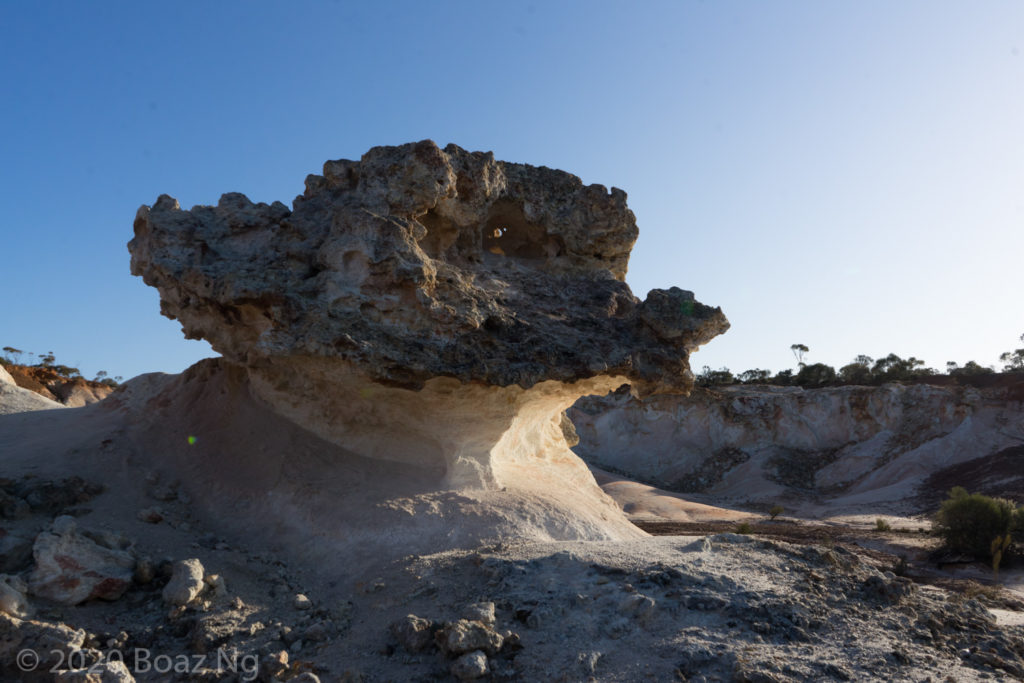
Buckley’s Breakaway 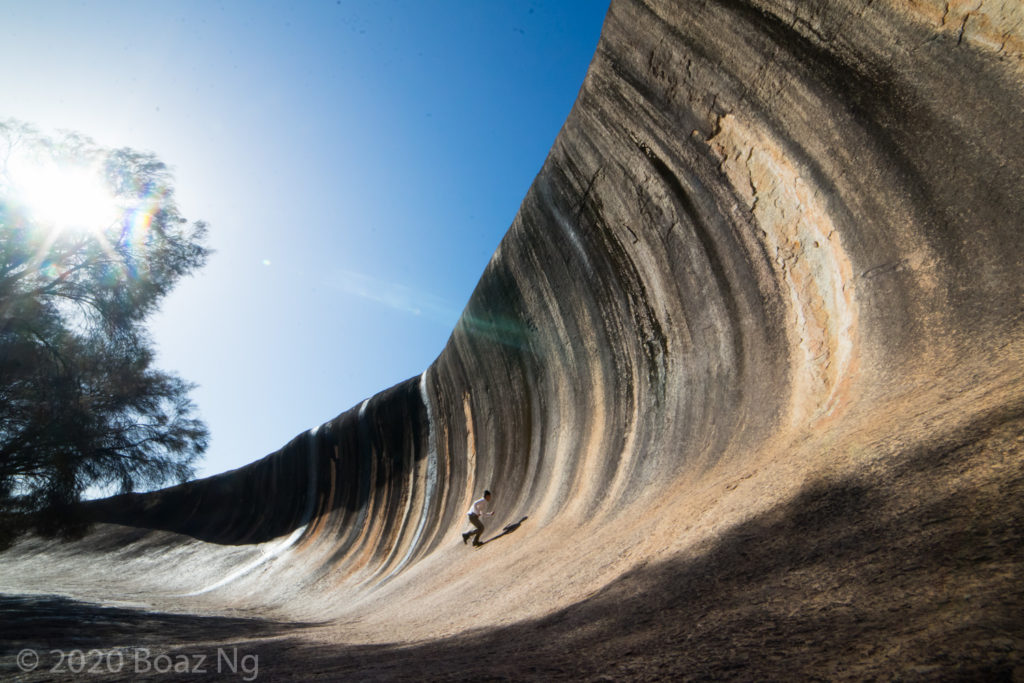
Wave Rock
Hyden is known for its tourist attractions, mainly consisting of various popularised geographical features. The following morning, I decided I might as well do some standard sightseeing, so I woke up early and made my way to Buckley’s Breakaway, a naturally eroded gully with dramatic rock features. I suppose the landscape was interesting but I was disengaged by the lack of sundews so I quickly took some photos and made my way over to Wave Rock. This iconic eroded feature lies at the base of the massive Hyden Rock and is shaped like a wave. I arrived when it was still too early for the regular tourists and had a lot of fun running up its side.
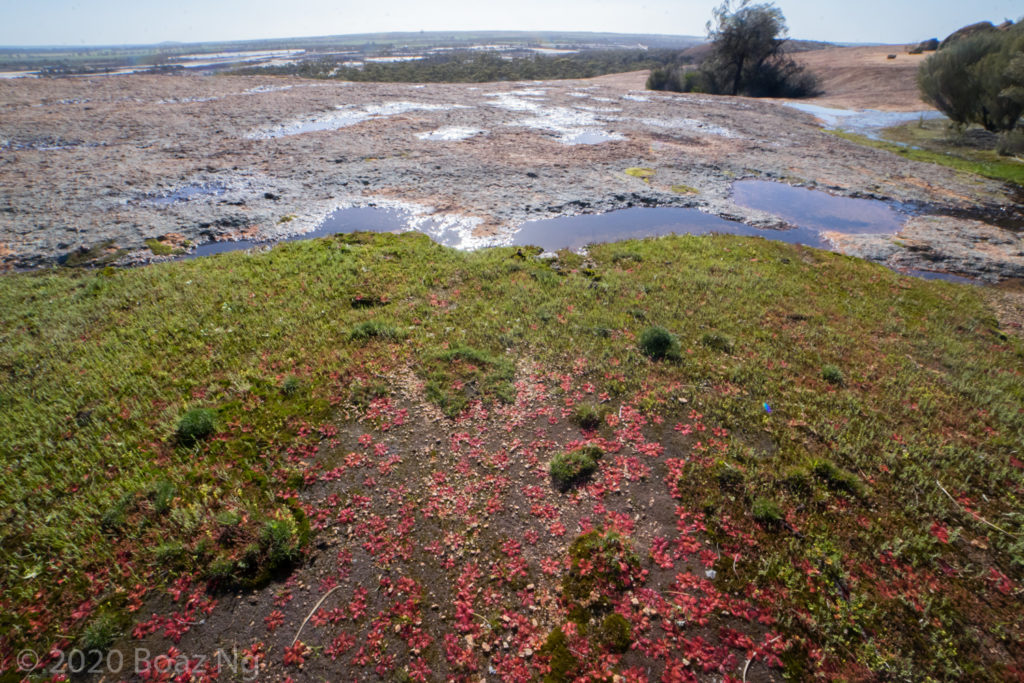
Drosera bulbosa on Hyden Rock 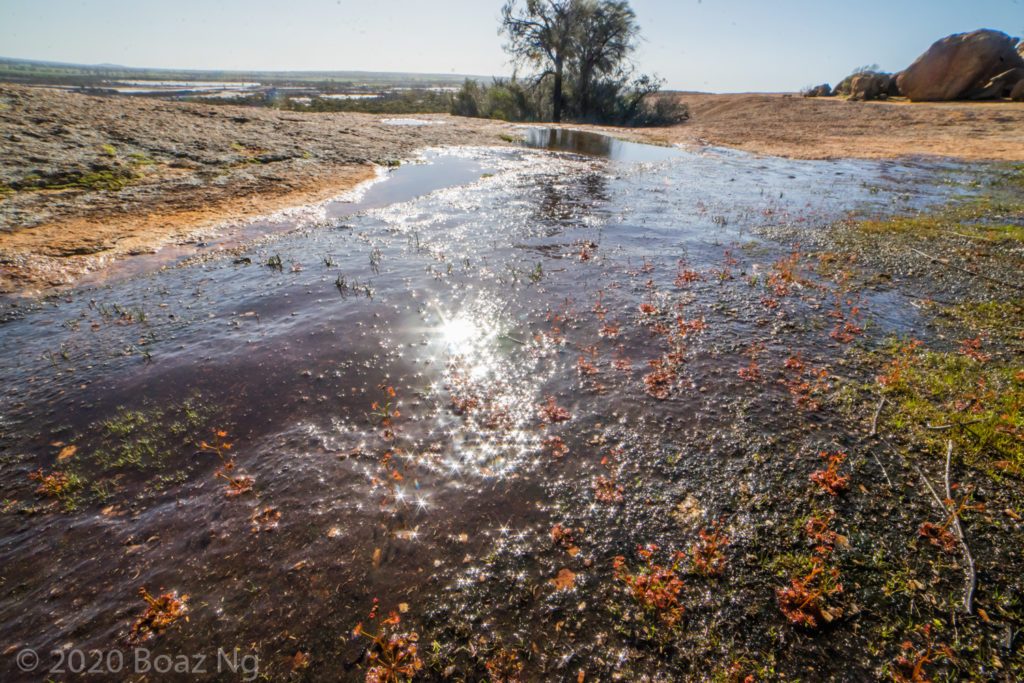
Drosera yilgarnensis 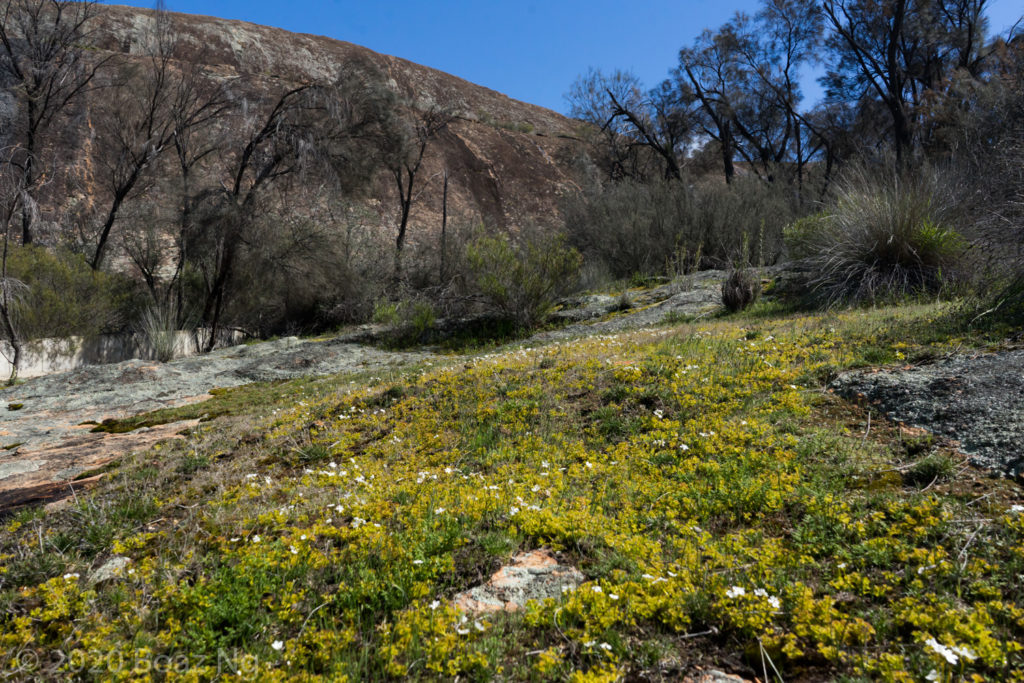
Drosera rupicola
Naturally, I turned my attention to searching for sundews and I soon found myself scaling the absolutely gigantic inselberg. The surface of the outcrop was so large that it hosted a range of niches, complete with streamlets, bushes, and moss aprons all entirely elevated from the plains. Drosera bulbosa grew freely where loam had accumulated and D. yilgarnensis, a western member of the D. peltata species complex, occupied the moss on the edge of bushy patches. I continued to a few more locations within the tourist park and found species like D. macrantha and D. rupicola. Whilst these were nice to see, I couldn’t help but notice how the area was disturbed by the thousands of tourists that visited them.
The salt lake sundews were still very much on my mind and the site I had visited yesterday left me with questions regarding their ecology. So for the remainder of the day, I resolved to find more populations of the plants, which is no easy task given that their exact locations are not publicly available. Thinking back to what I had learned the previous day, I found a promising site on the satellite and promptly made my way there.
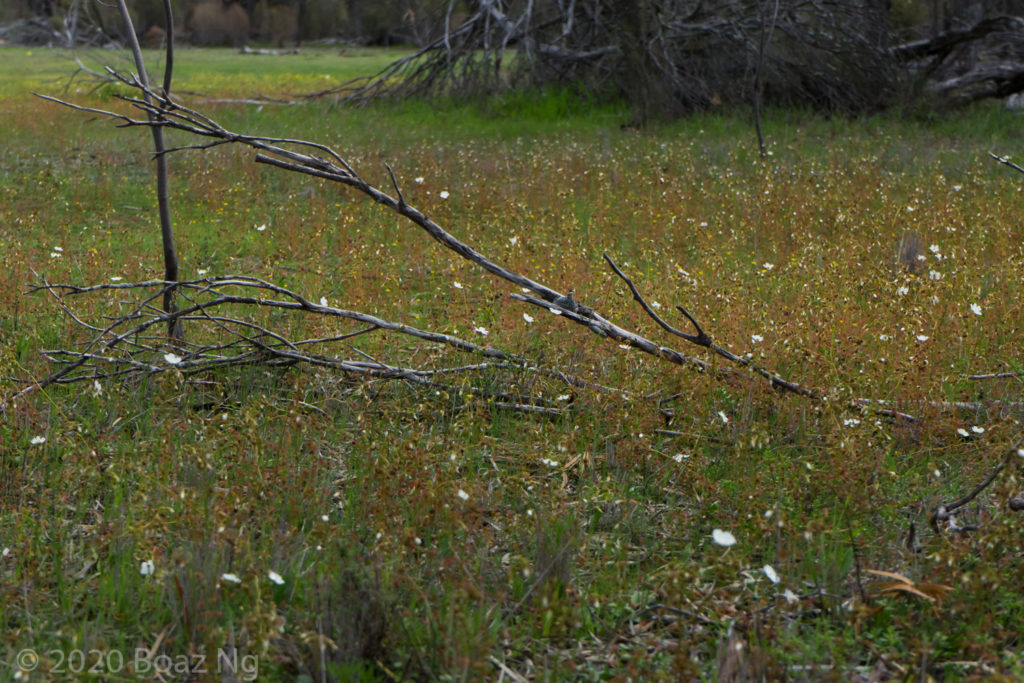
I drove as far as the car could take me and followed a farming trail through a field full of D. andersoniana to an outcrop at the edge of a system of shallow salt lakes. After a while of bush bashing through the forest, I finally broke out to the open sandy shores of the lake – but no sundews could be seen. Remembering that D. zigzagia preferred elevated flat plains, I walked along the perimeter of the woodland until I came to an open area and sure enough the species was there! The plants at this site were in full bloom and I was enamoured by their pastel yellow flowers. It seemed that the plants weren’t particularly rare provided that their niche of flat quartz plains was present. However, D. salina could not be found anywhere nearby.
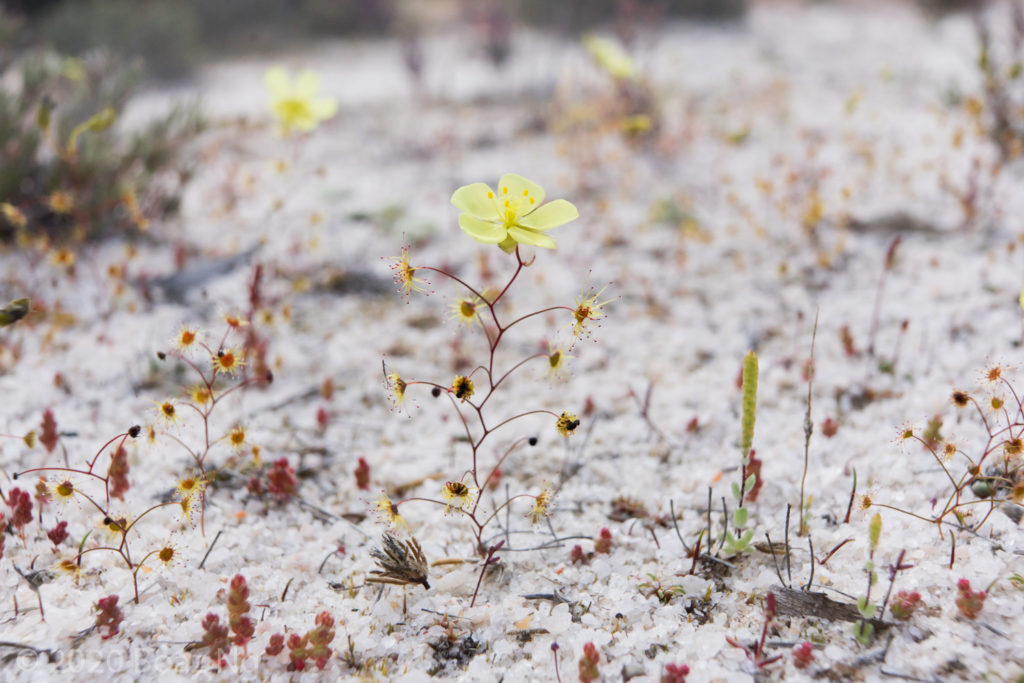
A bit perplexed by its absence, I re-examined the situation and recalled that Drosera salina seemed to grow only on sloped surfaces. Perhaps the seepage of water out of surrounding elevated bushland was needed by the species? For that to occur, a particularly deep salt lake would be required as an elevation gradient between the saline lakes and fresh groundwater layer had to be present.
Regathering, I found another site on the satellite around 50 km away and promptly made my way to it. At this location, a remote granite outcrop adjoined a large salt lake, so I thought that the area where freshwater from the rocks drained into the quartz field of the lake might provide the ideal habitat.
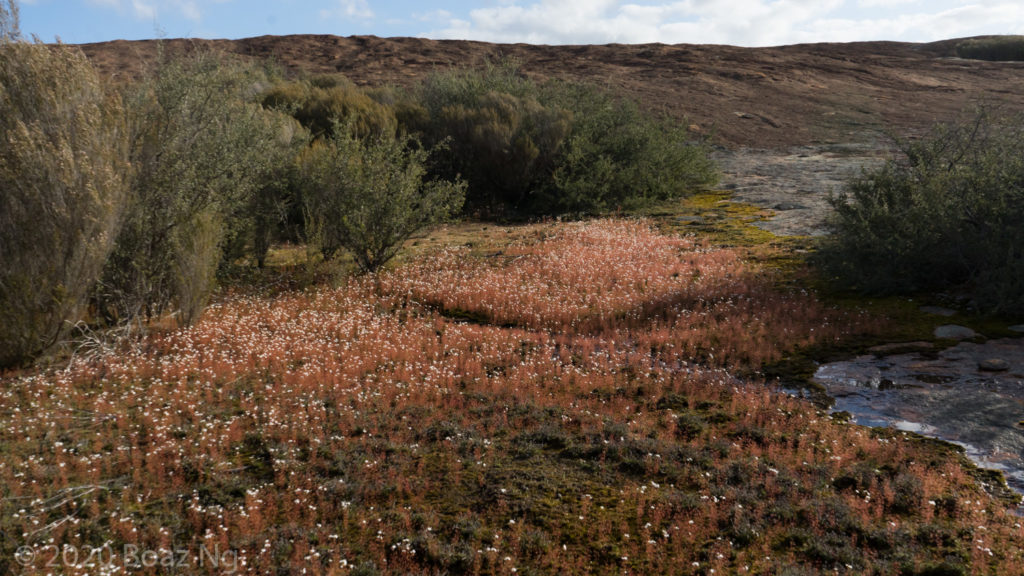
As I reached the location, I was presented with the most beautiful sight I had seen so far in my trip. The undisturbed outcrop was surrounded by endless fields of D. graniticola growing in great numbers. Against the vivid blue sky and the rusty coloured rock, the plants caught the rays of the low afternoon sun and illuminated the area with a glowing copper aura. I also found substantial amounts of D. yilgarnensis and D. stricticaulis growing in pockets of moss on the rock. Traversing the outcrop towards the lake, I took great pleasure in the natural surroundings, watching the sundews sway gently in the breeze with the warm sun against my back.
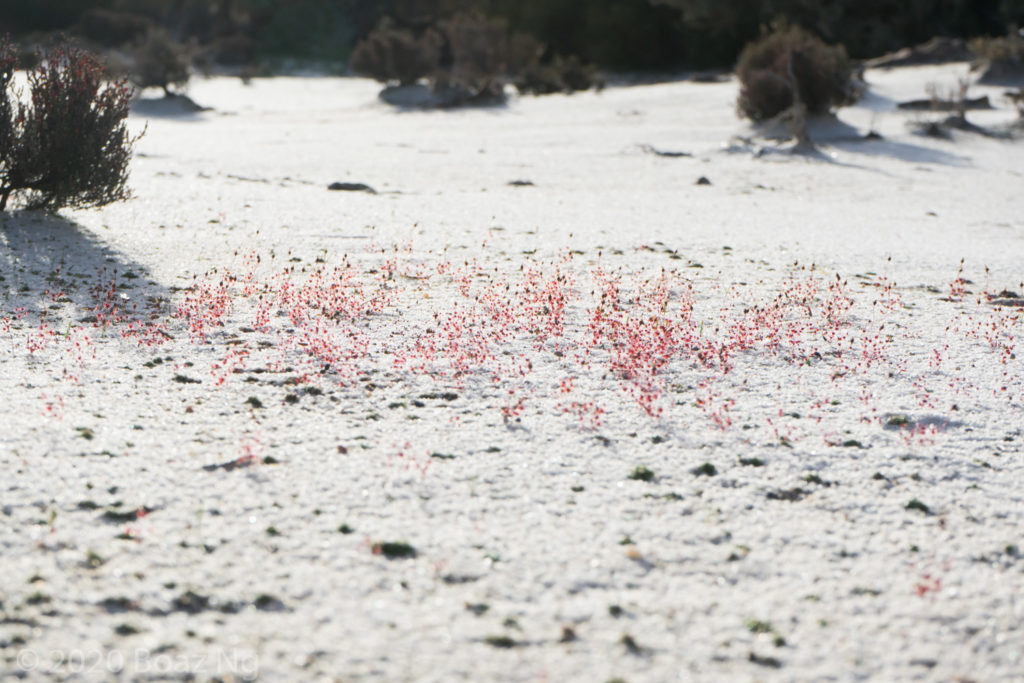
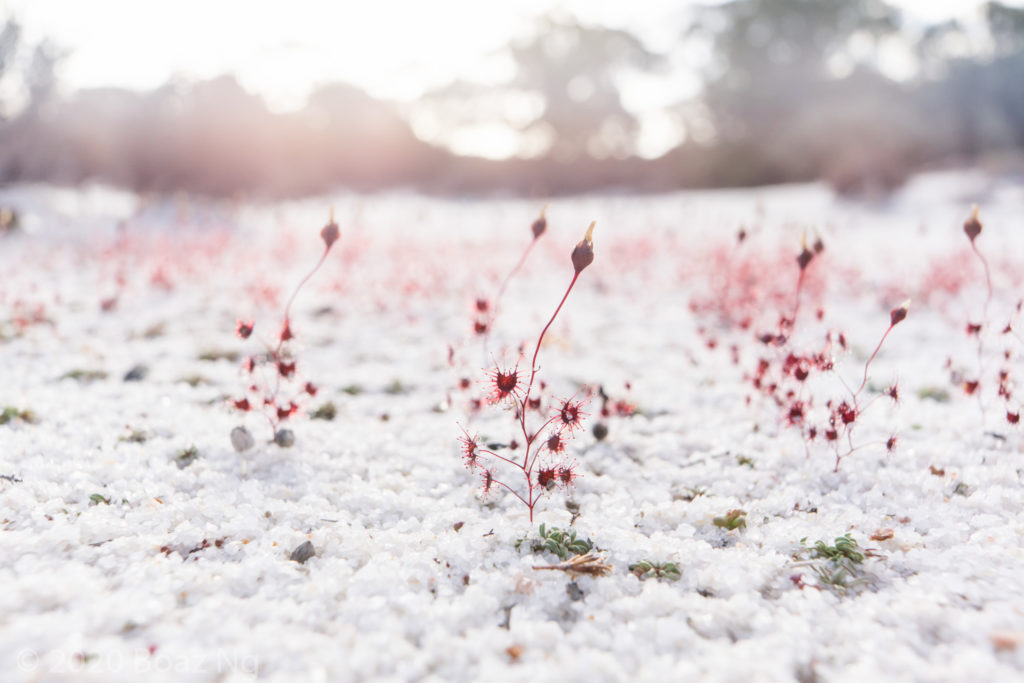
Finally, I reached the salt lake and my eyes were immediately drawn to the patches of red on the sandy banks of the streamlet that drained from the outcrop. Thousands of D. salina grew at this location, providing a highlight to cap off an already perfect day! Equally stunning was the fields of D. zigzagia that grew in the flat plains higher up.
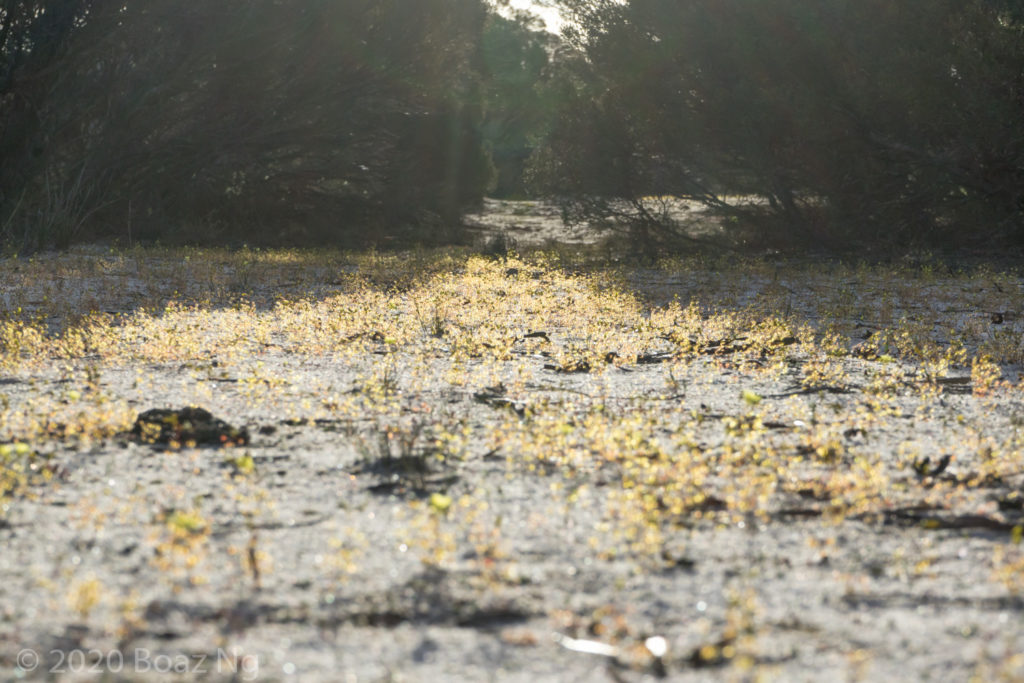
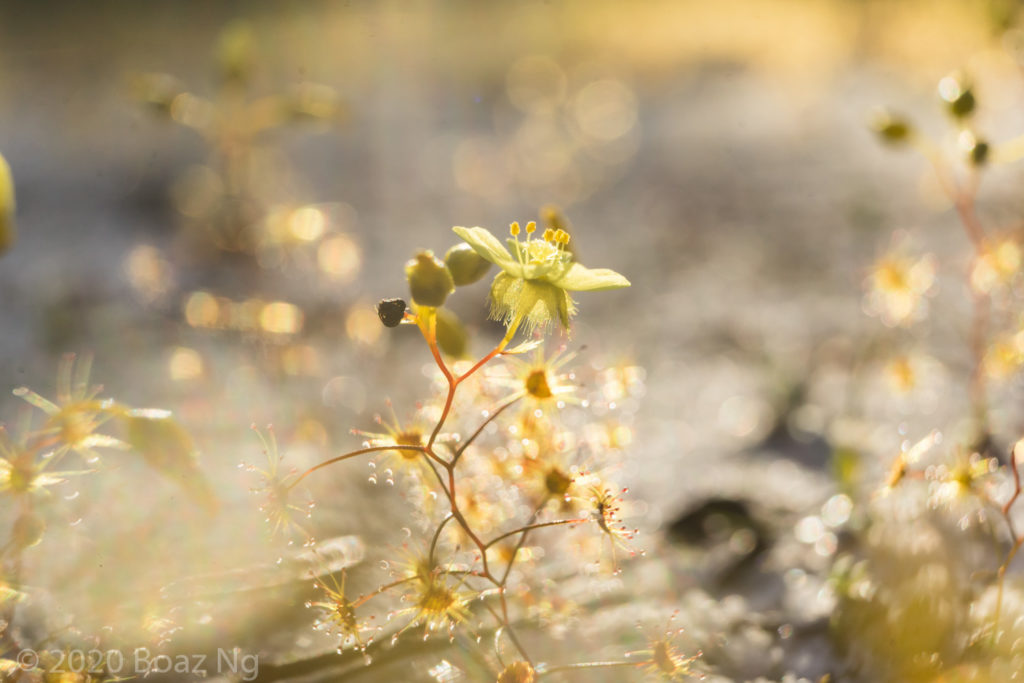
After observing the plants at this extensive site, I finally began to understand their respective niches. Both species require a coarse quartz substrate, which is deposited by the permanent saline watercourses in the Wheatbelt. Whereas D. zigzagia requires a deep sand base, D. salina additionally requires a sloping surface and appears to occupy the thin zone where groundwater seeps out from the surrounding bushland, perhaps benefiting from the deposition of some mineral component. This elevation gradient is rare, only forming around the deepest salt lakes, and explains why D. salina is much more uncommon than D. zigzagia. I spent the rest of the daylight at the site, photographing the plants in the rich glow of the setting sun.
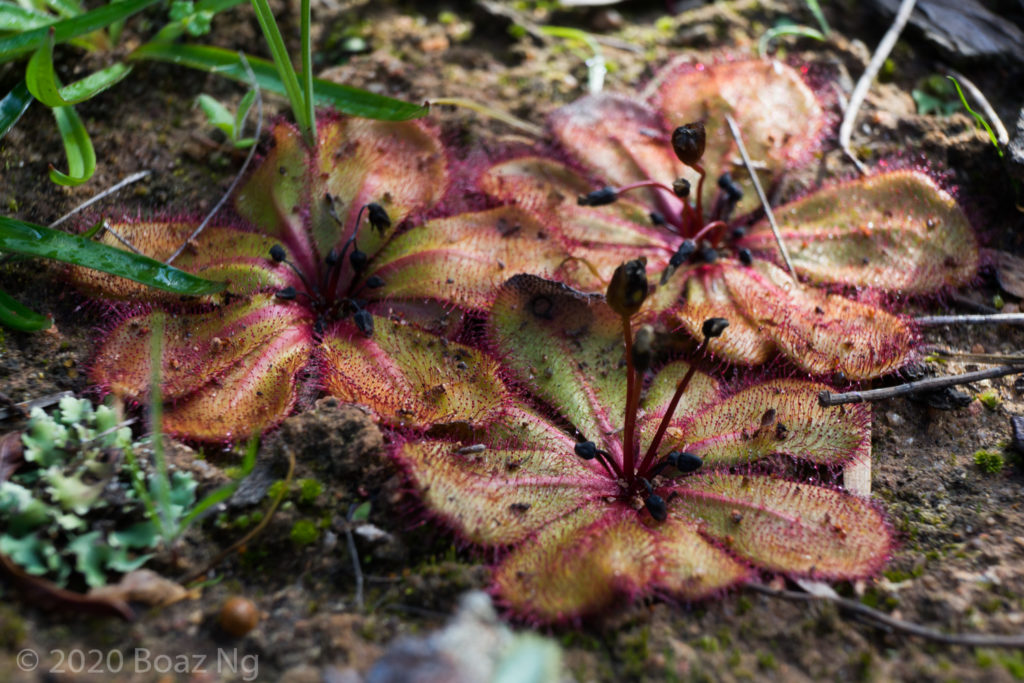
Drosera monantha 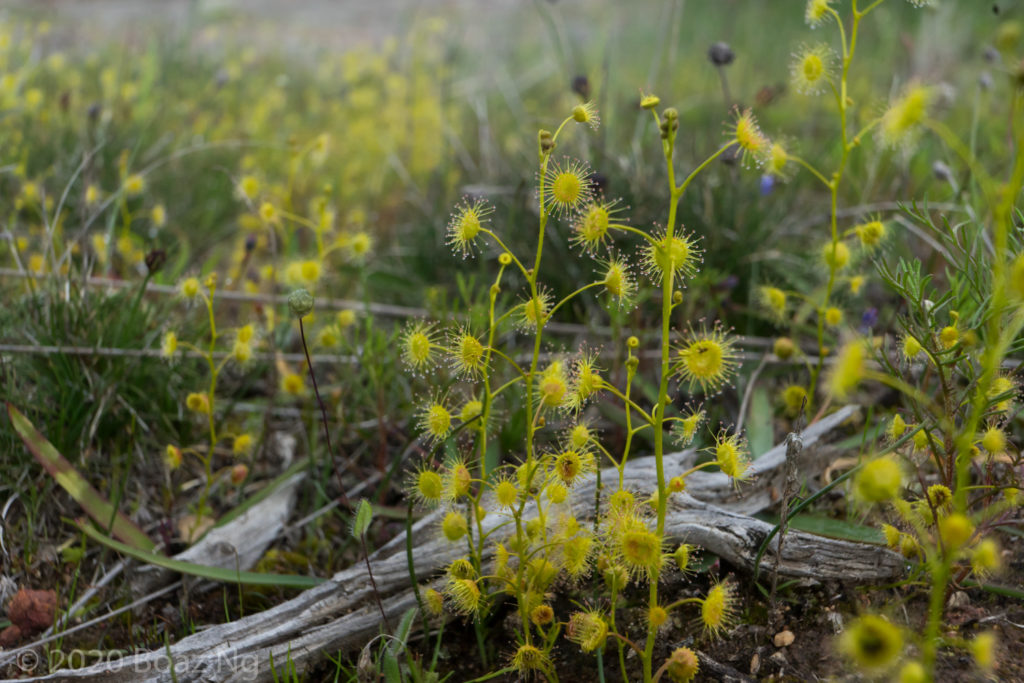
Drosera stricticaulis 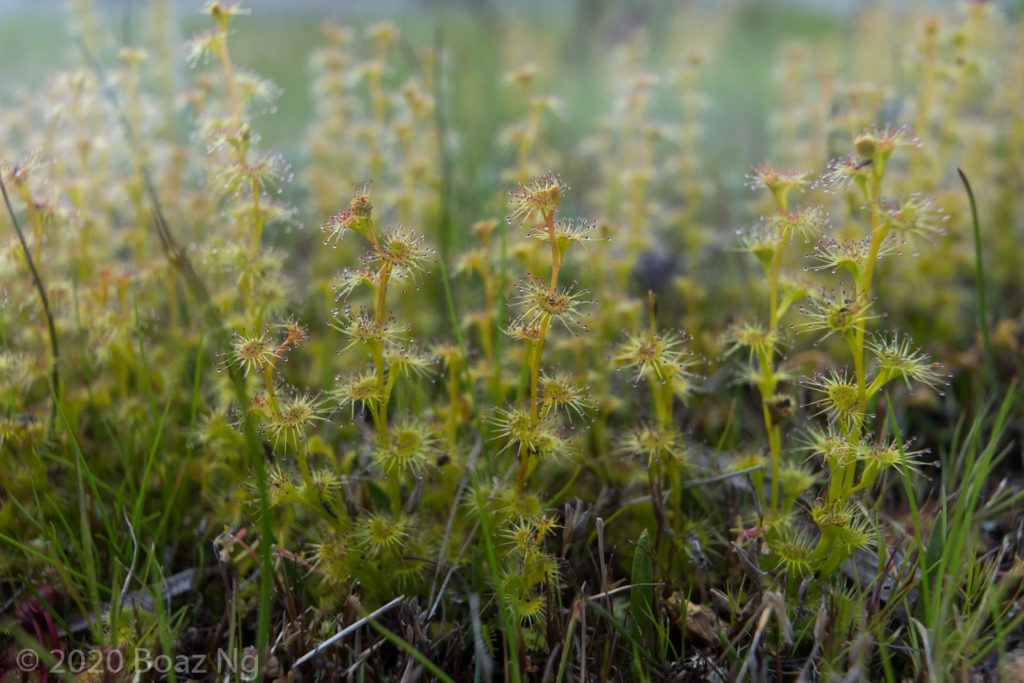
Drosera ramellosa
Having located all I had set out to find in the Wheatbelt, I drove back to Perth the following day, using the occasional outcrop as rest stops. At the first site, I found D. monantha growing amongst the grasses. The large rosetted species was a surprising find and I wasn’t even aware that it existed at the time! At the next location I unexpectedly saw a small patch of D. ramellosa occupying a moist mossy pocket in granite. This species in the stolonifera complex can be distinguished from its relatives by its erect stems and flowers that emerge directly from its basal rosette.
It wasn’t long before I reached the base of the Darling Scarp, a band of hills that runs parallel to the coast and separates the Wheatbelt from the ocean. To reach Perth, I would have to drive through the densely forested area, which is fed by high rainfall from orographic lift of the humid coastal winds. I still had a few hours of daylight left so I took the opportunity to go on a hike and find some plants.
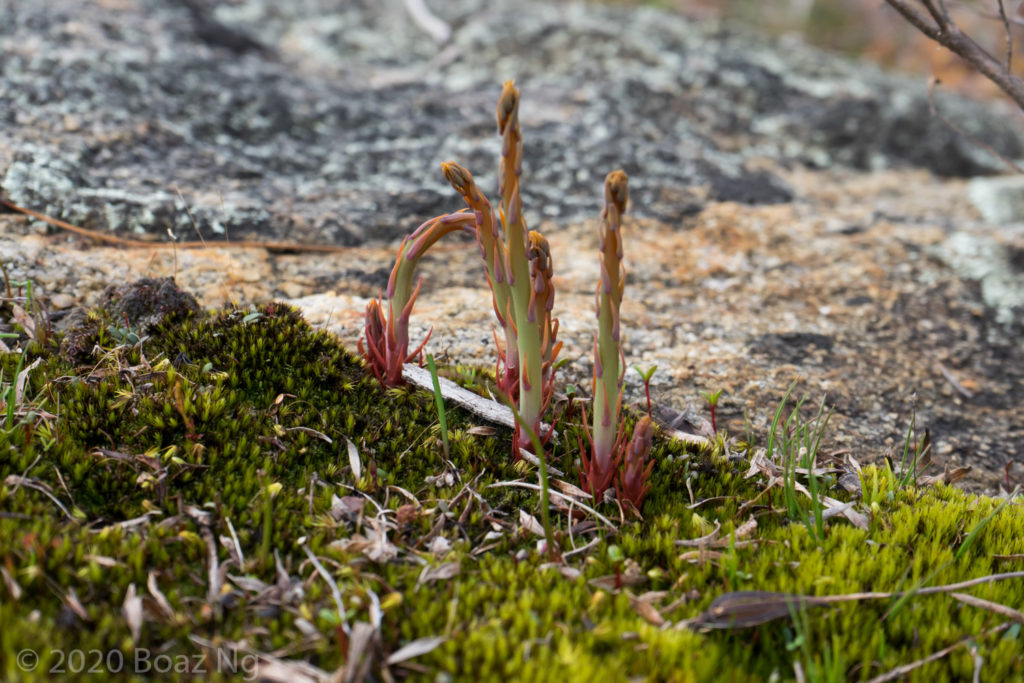
Drosera gigantea 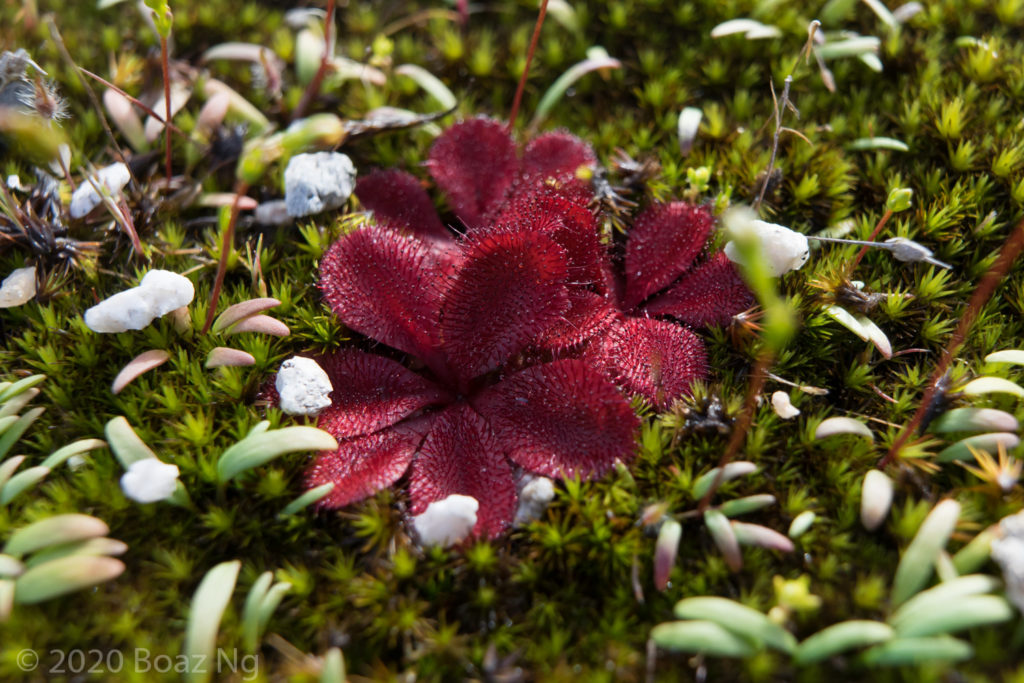
Drosera rosulata 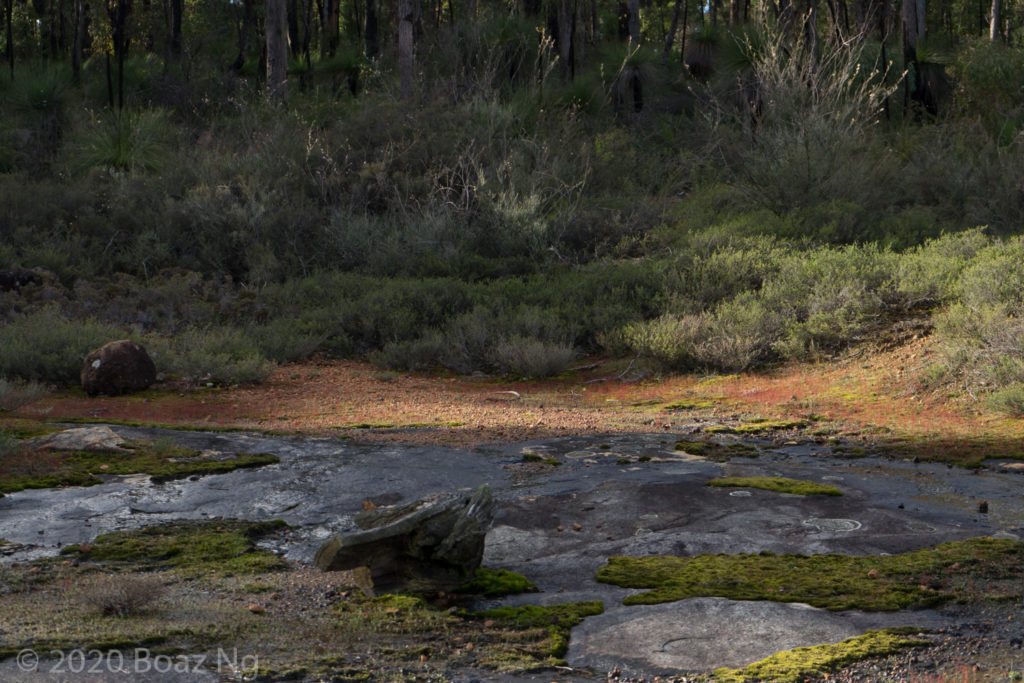
Drosera menziesii
In the hills, the frequent rain often exposes the granite base rock to the surface, especially around the many creeks that flow in the area. A goal of mine was to find D. gigantea, which grows abundantly in waterlogged soils in the area. I was successful in locating the early growth stage of the species, which has an uncanny resemblance to asparagus shoots, but it was still too early to see any mature plants. I also saw plenty of the rosetted D. rosulata and erect D. menziesii, which were both vivid red in colour, growing in the loam around the watercourses.
As the sun set I finally arrived back in Perth, completing my very long circuit of south-west Western Australia. I had driven some 700 km in the past three days alone, but my trip was far from over …

